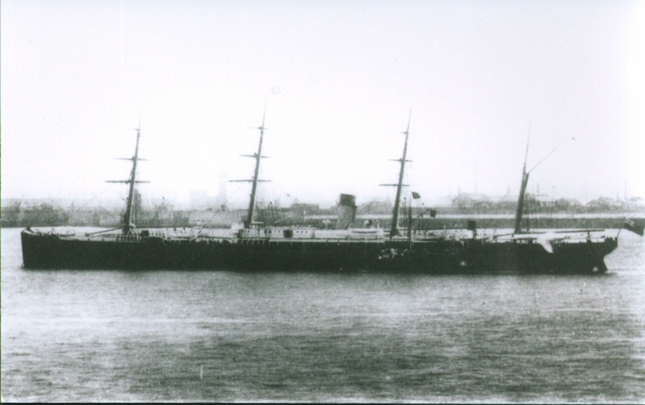by Melinda Creech
Graduate Assistant, Armstrong Browning Library
The Oceanic Steam Navigation Company, more commonly known as the White Star Line, was a prominent British shipping company. Founded in 1845, The White Star Line, operated a fleet of clipper ships that sailed between Britain, Australia, and America. The ill-fated Titanic was perhaps their most famous ship. The Armstrong Browning Library has a few connections to the Titanic. One connection relates to a set of postcards that disappeared with the Titanic and another relates to the author of the hymn, “Nearer, My God, to Thee,” the song that was purportedly playing as the Titanic sank. The Armstrong Browning Library’s collection includes a letter with the White Star logo in its heading and several letters written on board ships or while individuals were preparing to board ships. The letters, written between 1841 and 1912, are lines from people who were passengers on S S (Steamer Ships), RMS (Royal Mail Steamers), or HMS (Her Majesty’s Ship). It is interesting to note that one of the first purposes of steamers crossing the Atlantic was to deliver the mail. These lines, written from steamer ships, may shed some light on the adventure and danger presented by steamer travel in the late nineteenth century.
Charles Sumner (1811-1874) was an American politician, a senator from Massachusetts, and leader of the anti-slavery forces in the state. He traveled to Europe in 1872 for the last time and returned on SS Baltic.
The following letter was written while he was aboard the SS Baltic. It is addressed to Elisabeth Benzon.
In the letter Sumner mentions the Smalleys, John Bright, and the Storys. The Benzons, Smalleys, and Storys were correspondents of Robert and Elizabeth Browning, and Sumner himself had been acquainted with Brownings in Florence in 1859[1].
Sumner described the beginning of his trip thus:
The steamer is moving with dignified calm, like a [Lord] [Morgan’s] [panama], & we have the promise of a pleasant voyage. I breakfasted this morning at the table. In no former voyage from Liverpool have I seen the table from the leaving of the Mersey to the sight of Boston Light.
However, the trip did not continue so peacefully. According to the records of the White Star Line (http://www.norwayheritage.com/p_ship.asp?sh=balt1) he arrived in New York on the morning of November 27 with severe storms having been reported.
The SS Baltic was an ocean liner owned and operated by the White Star Line, one of the first four ships ordered by the White Star Line from shipbuilders Harland and Wolff after Thomas Ismay bought the company. The Baltic was originally to be the Pacific, but her name was changed at the time of her launching due to another vessel, owned by a different shipping line, named the Pacific that had recently struck an iceberg and sank resulting in multiple deaths. White Star quickly changed the name to the Baltic, or most likely no one would have booked passage on her, because people were quite superstitious in those days. The Baltic was a state-of-the-art ship for her day, carrying 1,000 passengers and accommodating 1st, 2nd and 3rd class passengers. In 1888, this vessel came under the command of Edward J. Smith, later the Captain of the Titanic. It was his first command in the White Star Line. In 1889, after the SS Teutonic entered service, the Baltic was sold to the Holland America Line and renamed the Veendam after the Dutch city of that name. On 6 February 1898, the Veendam hit a derelict ship and sank, with all on board saved.
In 1903 another ship was built by the White Star Line and named the Baltic.
That ship sailed from 1904 until 1933. At 1.40 p.m. on 14 April 1912 the SS Baltic sent this message to RMS Titanic:
Captain Smith, Titanic. Have had moderate variable winds and clear fine weather since leaving. Greek steamer Athinai reports passing icebergs and large quantity of field ice today in latitude 41.51 N, longitude 49.52 W.
At 1:15am on 15 April the SS Baltic responded to the distress call, turned around and made its way to help with the recovery effort after the sinking of the RMS Titanic. After the ship had traveled 134 miles, it was advised to turn around and return to Liverpool. The Carpathia had picked up the 20 boatloads of survivors from the Titanic and was returning to land.
[1] Browning, Robert. Selections from the Poems and Plays of Robert Browning. Scott. Foresman, 1919, 23.




